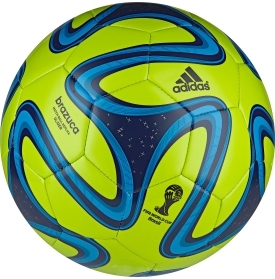Soccerball Polyhedra Mania
This brazuca soccer ball

has hexagonal faces, pentagonal faces, and some swirls that makes it look covered with crosses, all symmetrically arranged. It seems possible to rotate the ball so that the design realigns with itself (if we disregard printing and logos). The regular polyhedra are:
I Tetrahedron
II Cube
III Octahedron
IV Dodecahedron
V Icosahedron
A symmetry transformation is a function (or operation) that leaves unchanged, that is, . If we apply, say, the same symmetry transformation which leaves leaves the tetrahedron unchanged to this soccerball, it will either leave the soccerball unchanged, or not. Which of these solids one can apply all the rotation symmetry transforms to both the regular polyhedron and the soccerball, and leave both unchanged?
Note that only rotation transforms will be considered here, that is, as the soccerball is in play, how can it re-align with itself? Both the seams and the swirls are to re-align with itself.
This section requires Javascript.
You are seeing this because something didn't load right. We suggest you, (a) try
refreshing the page, (b) enabling javascript if it is disabled on your browser and,
finally, (c)
loading the
non-javascript version of this page
. We're sorry about the hassle.
We know that the brazuca soccer ball is "covered with crosses", the vertices of which are those dark triangular spots. Using the Euler characteristic for polyhedra, we have V − E + F = 2 . But we know that because 3 crosses meet at a vertex, and 2 crosses meet at a (wavy) edge, so we have 3 V = 4 F and 2 V = 4 F , which can be plugged into this equation and solved for F , the number of faces
3 4 F − 2 4 F + F = 2
giving us F = 6 , which means the black-and-blue wavy lines have (rotational) cubic symmetry. Meanwhile, the seams are that of the classic truncated icosahedron, which has 1 2 pentagon faces and 2 0 hexagon faces, exhibiting both dodecahedral and icosahedral symmetry. But when combined, one can see in the picture that the wavy lines from the dark vertex in the center crosses into pentagon faces, while the wavy lines from the dark vertices next to the one in the center crosses into hexagon faces---thus breaking the cubic symmetry, and allowing only tetrahedral symmetry.
If one draws the projection of a cube and a truncated icosahedron onto a sphere (aligned as suggested by this brazuca soccer ball), the edges projected by the cube will share the same edge shared by one hexagon and one pentagon. However, for any one face of the cube, 2 of each will be outside of it, and 2 of each will be inside of it, so there is no true cubic symmetry, but there remains a tetrahedral symmetry.